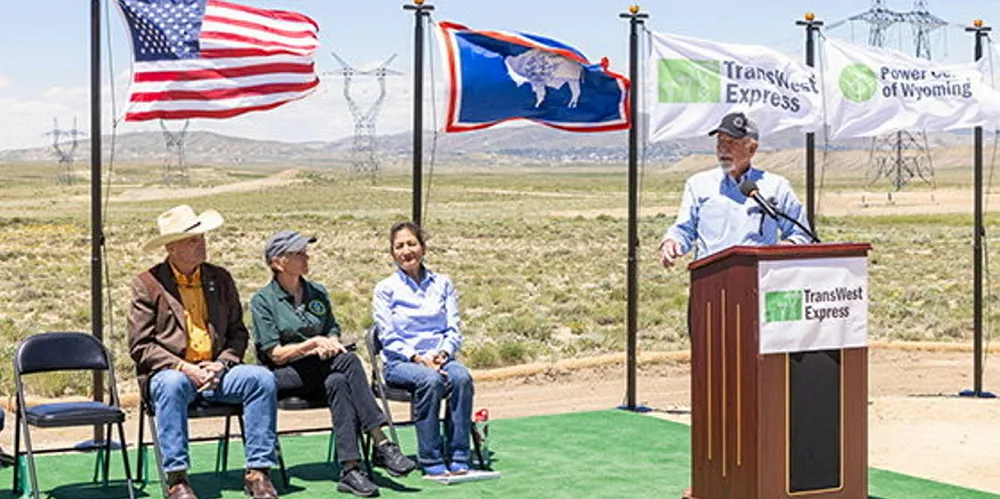US $5bn onshore wind mega-project eyes federal incentive bonuses
Chokecherry and Sierra Madre in Wyoming now aiming for 3.5GW capacity

CCSM will be similar in size to SunZia in New Mexico, the largest onshore wind project in the western hemisphere that is due online in early 2026. By contrast, the biggest offshore wind array is Dominion’s 2.64GW CVOW with a late 2026 commercial start.
Power Company of Wyoming (PCW) now envisions installation of 600 turbines, down from the 1,000 expected late last decade and potentially 2,000 foreseen during early stages of project development in 2008-12. This reflects turbine technological advancements resulting in larger average nameplate capacity, hub height and rotor diameter.
“We are still trying to figure out the final layout for the project,” said Kara Choquette, director of communications and government relations. “We have not selected a final turbine model or vendors yet. They could be in the range of 4MW to 6MW each.”
PCW is working with vendors – she did not name them – to qualify the project for a PTC 10% domestic content bonus worth an initial $2.75/MWh over the first decade of operation.
The developer also believes the project is in an energy community, making it eligible for another similar value PTC bonus.
It cites a searchable mapping tool issued in April by the Department of Treasury that identifies communities formally dependent on fossil fuels where new clean energy facilities can qualify. Coal had been mined for decades in Carbon County which still produces oil and natural gas.
The domestic content and energy community bonuses, when added to the PTC base rate of $27.50/MWh – if apprenticeship and prevailing wage requirements are met – would bring the project’s tax credit eligibility to $33.00/MWh. The base rate will be adjusted annually for inflation, making the subsidy potentially even more lucrative.
Choquette said the initial 1.7GW phase will employ 225 turbines and operate commercially by the end of 2027. This will roughly match first-stage carrying capacity of the $3bn TransWest Express transmission line whose purpose is to deliver clean electrons generated by CCSM to Arizona, California, and Nevada.
The second CCSM phase will utilise 375 turbines and enter full operation later in the decade, again to coincide with TransWest raising throughput capacity to 3GW by the end of 2028.
Power Company of Wyoming and TransWest are wholly owned affiliates of The Anschutz Corporation, a holding company for billionaire entertainment mogul and oilman Philip Anschutz’s various business activities.
Equity and debt
The company anticipates it will fund 35% of CCSM with equity and 65% with debt. contending it is “confident it can secure the equity financing component … through its own means or in combination with other equity partners,” according to its state permit applications.
The Anschutz Corporation’s Overland Trail Cattle Company owns a 320,000 acre (129,500 ha) working ranch south of Rawlins/Sinclair in southern Wyoming on a combination of private and federal lands where CCSM will be built and site of TransWest’s high-voltage direct current terminal.
This unique arrangement is a throwback to Congress in 1867 approving a land grant for construction of the Union Pacific railroad, which received several thousand acres of land for each mile of track it completed on the way to Utah.
Those sections were interwoven with an equal amount of public land, creating an immense checkerboard pattern. Ownership of the private lands has changed multiple times since then in most cases.
Both the wind farm and related power line required federal environmental approvals there, a process that took 11 and 15 years, respectively, highlighting a flawed US permitting regime for large clean energy infrastructure projects. BLM finally issued construction notices to proceed for both CCSM phases in 2017 and 2019 and TransWest this year.
South-central Wyoming has the nation’s best onshore wind resource, but remoteness from major markets has largely precluded much development. This is starting to change. PacifiCorp, owned by billionaire Warren Buffett’s Berkshire Hathaway Energy, is building wind farms there.
TransWest will interconnect with PacifiCorp’s grid in Wyoming, providing access to other western states.
TransWest will also link with Los Angeles Department of Water & Power and Intermountain Power systems in Utah, and with NV Energy system in Nevada, and a grid that is operated by California ISO (Caiso).
PCW continues to look for buyers for the electricity. “There is no movement to report,” Choquette said.
After Texas, California is the second largest US state power market with a hugely ambitious non-binding 100% clean electricity goal by 2045. Given self-imposed obstacles such as zoning laws that preclude most onshore wind development and help keep power prices far above the national average, lower cost renewable energy from CCSM would seem a viable alternative.
Yet, California, dominated by the Democratic Party’s left, and Wyoming, a conservative Republican bastion, have little in common politically. That includes energy and some California elected officials and policymakers are resistant to imports from Wyoming, which produces 40% of the nation’s coal.
That attitude may ease given California has struggled to reduce dependence on natural gas for power generation, about 35%, with coal still being burned. Getting to 60% renewables on the gird by 2030 may require ramping imports.
(Copyright)